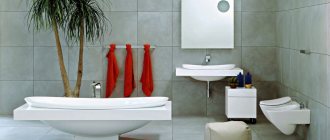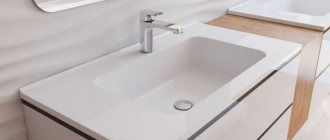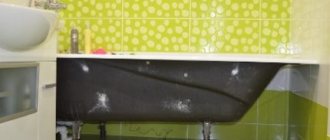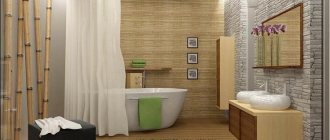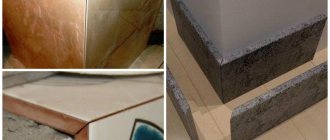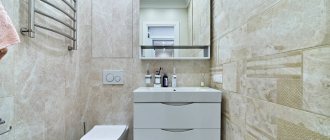In the bathroom, a good and quick renovation can only be achieved with high-quality materials. Because there is a constant change in temperature, now cold, now hot water hits the facing coating. Ceramic tiles are an excellent option for the bathroom. But which tile should you choose, and most importantly, which pattern and size should you choose? So that everything doesn’t sound so panicky complicated, let’s look at everything point by point and the first question we’ll focus on is the type of tile.
Marble tiles from the Windsor collection from the Kerama Marazzi factory
Classification of tiles by format
In professional circles, tile sizes are called format. This refers to the area of the product. There are three indicators in total:
- small format;
- average;
- widescreen.
When covering walls, you can use all of them, but not every model can be suitable for the floor. In addition to the standard size, the products differ in thickness. For wall structures, thinner types are produced. This is explained by the fact that there is almost no mechanical impact on the surface, unlike the floor. The thinner the tile, the easier it is to lay, and cheaper mixtures can be used to adhere to the wall.
Warning. Floor products can be used on walls, but reverse replacement is not permitted.
Classification is carried out according to form. There are several main types:
- triangular;
- square;
- rectangular;
- pentagonal;
- hexagonal;
- octagonal.
Basic forms
Due to inexperience, you can choose a sample of the wrong size.
Let's try to understand this difficult matter.
Large format modules
There are tiles on sale in large sizes, square (150x150) and rectangular (20x60). It is often used for wall cladding in large bathrooms. Their use makes it possible to obtain a surface with a minimum number of seams. The use of large-sized modules simplifies the cladding process and significantly reduces repair time. The end result is a monolithic effect surface that boasts high waterproofing properties. Cleaning ceramic tiles is much easier than cleaning small tiles. But during the installation process, such material, as noted above, produces a lot of waste; large tiles can only be laid on a perfectly flat base. Without experience in laying tiles, laying large-format tiles yourself will be very problematic.
How to determine dimensions
One rule should be taken into account: when decorating walls, select samples that correspond to the parameters of the room. If the room is spacious, then choose a larger one. It is not recommended to use large-format products in a small room. For low ceilings, the cladding is made with rectangular tiles, laid out vertically. In houses with high ceilings, the pattern is reversed, and it is important to emphasize the horizontal lines. Therefore, the long sides should be horizontal.
Do not forget about the influence of the tile surface, because the structure also affects the volume. The glossy surface visually expands the space.
Types of ceramic layouts
In addition to the standard method, square tiles are laid in the form of diamonds.
The rectangular tile is oriented with its elongated side horizontally and vertically.
Sometimes rectangles of tiles are laid diagonally on the wall.
By varying different tile sizes and colors, you can obtain surfaces of the most varied shapes and colors.
Here are some examples of tile layout:
What sizes are flooring products?
For the floor, square tiles of the following sizes are traditionally chosen:
- from 50 to 300 mm. in increments of 50 mm;
- 327x327, 330x330, 350x350;
- 400x400, 408x408, 450x450;
- from 500 to 1000 mm., step is 100 mm.
Larger specimens are rarely used. The most common option is 300x300 mm.
Explanation. The thicker the product, the greater the load it must withstand. This has a significant impact on weight.
Rectangular products are used:
- standard: 30x60, 30x120, 40x60, 45x90, 50x100, 60x90, 60x120 cm;
- wood: 12x45, 15x45, 15x60, 16x99, 19x120, 20x50, 20x60, 22.5x90, 25x100.25x120 cm.
Manufacturers are constantly expanding the list and adding new dimensional characteristics.
Warning. The smaller the format, the more labor-intensive the installation.
Format table
The best option is:
- 100x200 mm;
- 150x200 (300) mm;
- 200x300 mm;
- 300x400 mm.
There are non-standard assortments that are used to create various designs.
Kitchen tiles
The regulation of kitchen floor tiles is not much different from others. The choice depends on the area and interior. It should be noted that small square-shaped samples are often used unless special decoration is provided.
For kitchen
Small kitchen products make the kitchen more comfortable and homely. It is known that using a small format helps to avoid increased waste that occurs when cutting. Often it is necessary to bypass structural elements that differ from rectilinear forms. For safety reasons, it is better to select samples with a rough surface, which will serve as protection against slipping.
What's suitable for the bathroom
The bathroom has a small area. Plumbing pipes may pass through the floor, making installation difficult. Therefore, the best option would be to use medium format products. It is recommended to use a coating with a structured surface. More often they choose tiles with sides of 300x300 mm. and smaller, up to 50x50 mm. Rectangular types from 100x200 to 300x400 mm are used.
Indicative table
In addition to standard ones, unique formats are sometimes used. Large-scale elements serve as a background, and small-scale elements create the desired ornament.
What are the sizes of wall tiles?
For enclosing structures, samples of different shapes are used:
- square;
- rectangular;
- polygonal;
- in the form of a panel.
The main types of wall products have the following sizes:
- small format (60, 90, 120 mm);
- average value (180, 200,240,300,400,600);
- large up to 1200 mm.
Rectangular ones are also divided into three groups:
- 25x150, 75x150, 100x150, 100x200, 150x200 mm;
- 150x225, 250x300, 250x330, 250x400, 275x400 mm;
- 150x900, 300x600, 300x900 mm.
Wall samples
Polygonal types are available in small sizes from 150 to 250 mm. They may have an irregular shape.
Mosaic ceramics
Dimensions for bathroom and kitchen
Before choosing ceramics, you need to calculate its quantity. It is not enough to simply know the coverage area. To make installation less labor-intensive, you need to choose the size. The length of the masonry is divided by the width of the sample, plus the seam. The larger the ceramic, the larger the seam. For average values it is 3–5 mm. Sometimes large slabs are laid on the floor without seams, forming a monolith. If, when dividing the masonry distance by the sample, the remainder is very far from half, it is better to choose a different format or think about inserts.
Rectangular products with different aspect ratios are well suited as inserts, for example:
- 15x200 mm;
- 55x200 and 55x250 mm.
Samples from the lower indicator are inserted into the corner or used to visually divide the space. Ideal for edging the edges of a bathtub. Used for herringbone masonry. Parameters 15x200 are usually used when creating mosaics, which can have an area from 1 cm2 to 25 cm2.
Small squares are laid out diagonally. Medium square and rectangular samples are fixed directly or offset. Large samples are used only for the floor of large rooms. Some interiors may include this type of wall cladding.
The floor in the kitchen is tiled, because the walls are usually covered with kitchen furniture. Only part of the base remains open between the table and cabinets. This area is called an apron, but the owners themselves decide whether to cover it all or only part of it. The walls are covered with smaller, lighter material, and the floor is covered with large, rough, matte, darker color.
Corridor formats
Although the corridor is a non-residential room, you can immediately tell about the taste of the owners by its appearance. Small elements are rarely used unless they are original drawings or mosaics. By the way, mosaics can be made not only in small fragments, but also in medium format. For this purpose, products of different sizes are laid out. You can make a division: just before the threshold, use one format, and further along the corridor another. Everyone has their own taste, and you can’t subject everyone to the same rule. Some coating options are shown in the video:
To highlight the passage, long rectangular slabs are used. They, like sidewalk curbs, emphasize boundaries. Small rectangular pieces laid out in a herringbone pattern also look beautiful. Medium-sized square elements are often used, laid straight or diagonally.
Final work
After grouting the joints, excess mortar must be carefully cleaned with a foam sponge or a viscose napkin, and any unevenness in the joints must be smoothed out. The room must be thoroughly cleaned of construction debris and dirt.
Design of a long corridor in an apartment.
Vinyl floor tiles: application features read here.
How to glue vinyl wallpaper on a non-woven base: https://trendsdesign.ru/materialy/oboi/osobennosti-oklejki-sten-vinilovymi-oboyami-na-flizelinovoj-osnove.html
Dimensions of ceramic tiles
The thickness of these products ranges from a few millimeters to several centimeters. Sometimes ceramics mean porcelain stoneware, which is characterized by increased density and strength. It is often used on facades where a material that can withstand temperature and mechanical stress is needed.
Thickness often depends on size: the larger, the thicker. Tile material is divided into wall and floor. For walls where there is a weight limit, the thickness will be less; for the floor, on the contrary, it will be greater.
What should be the thickness of wall tiles in a bathroom?
The thickness determines what type of glue needs to be used and what layer to apply it. In this case, the base material is taken into account. For walls, choose a thickness in the range of 4–7 mm. Do not forget that the thicker the product, the more expensive it usually costs. Installation work is also becoming more expensive.
If mosaic is used, its thickness may be less than specified. Since it has a small area, this has little effect on its strength. The main thing is to follow the instructions for use. Sometimes products of different thicknesses are chosen for masonry, this makes it possible to create a three-dimensional pattern.
Thickness of floor products
Ceramic is a rather fragile material, so a thicker type is chosen for the floor. Moreover, the thickness depends on the load that will be placed on it. For example, for most rooms in the house 8 mm will be enough. This is a lightweight, cheaper ceramic. In the hallway or living room, a thickness of 11 mm may be suitable. Such plates have a sufficient margin of safety.
Thicker slabs are used in production areas. Porcelain stoneware, which goes through a different production cycle and has improved strength characteristics, is preferable.
Bath installation
It is better to install the bathtub before laying the wall tiles. The advantage of this installation is that the lining starts from the edge of the bathtub, so there will be no gap between the wall and the side of the tank. Another benefit is cost savings.
If the bathtub is installed after the room has been completely covered, a gap will form between the wall and the side of the bathtub that needs to be sealed. For this, moisture-resistant concrete is used. If the gap is wider than 1 cm, use a ceramic or plastic edge. Such installation is more labor-intensive and material-intensive and requires the services of an experienced craftsman.
Does size affect quality?
Manufacturers calculate the size and thickness to ensure the material is durable. Therefore, the dimensions of products should not affect quality. Most often, the formation of defects is associated with improper masonry. If the layer of adhesive under the tile is uneven, then the possibility of cracks in place of the voids increases. The glue must be of high quality and applied strictly according to the instructions, taking precautions.
When all the rules are followed, the format and thickness are chosen correctly, the coating will last for decades. The final video shows the main parameters of the tile covering:
